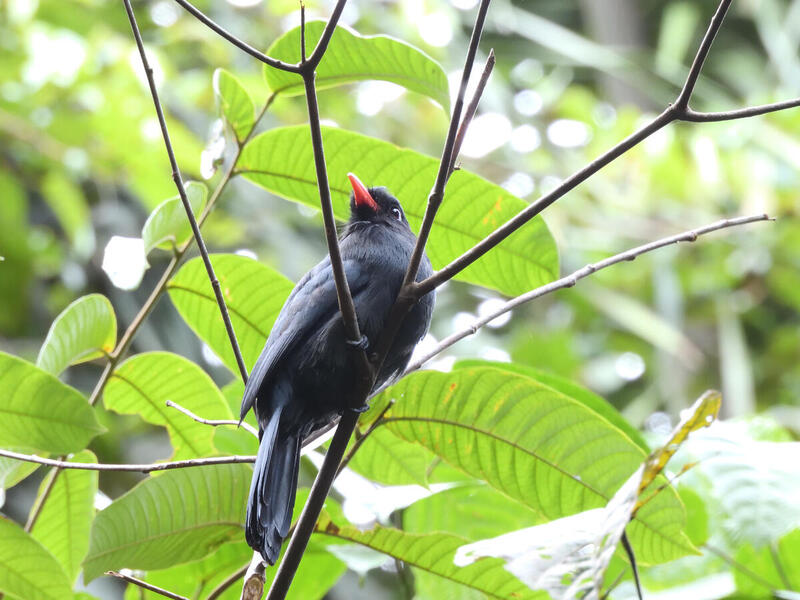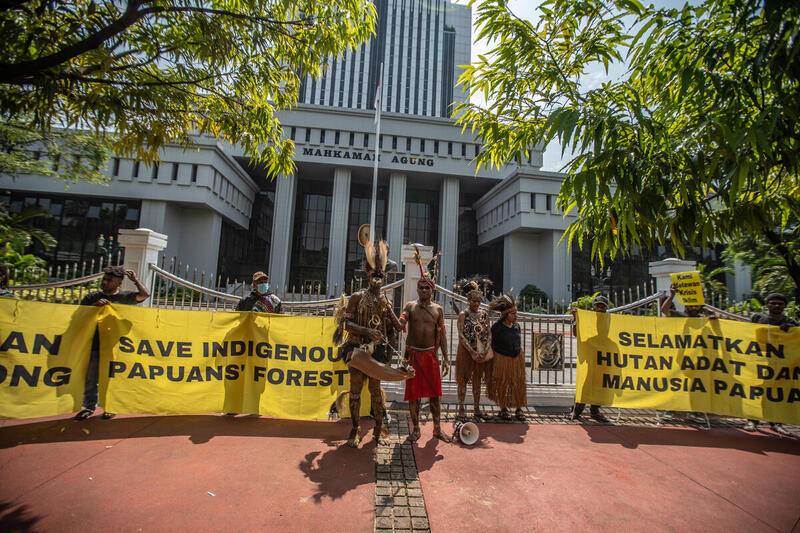Indigenous Peoples and Local Communities — traditional populations who have been living in a region for generations — have been living in harmony with forests around the world and fighting to protect their livelihoods and ancestral knowledge for generations. These forests are vital in our fight against climate change and home to vibrant Indigenous Peoples and Local Communities and vulnerable wildlife. Yet, the three largest rainforests in the world – the Amazon, in South America, the Congo Basin, in Africa, and Papua, in Southeast Asia, continue to face multiple threats from industrial agriculture, logging, mining, oil and gas exploitation, carbon and biodiversity offsets schemes and infrastructure development. Despite the hard-earned 2022 Kunming-Montreal Agreement recognising Indigenous Peoples’ work, knowledge and practices as the most effective tool for biodiversity protection, they still don’t have a seat at the table at climate and biodiversity negotiations.
Indigenous Peoples and Local Communities as guardians of the forest are slowly gaining ground through their forest protection and restoration initiatives, which if well funded could become viable alternatives to destructive activities. Recognising and funding these initiatives gives communities rights over their customary territories and resources and recognise them as stewards with traditional knowledge to manage forests and also reinforce the actions to protect the climate and ensure the wellbeing of all of humanity.
Here are three examples of communities who have been involved in the protection of their lands and ancestral knowledge and have been living in harmony with the forest:
Brazil
It takes a lot of courage and persistence to swim against the current and defend, for more than a decade, a heritage that once belonged to your parents and grandparents and will soon be passed on to your grandchildren. But that is exactly what the riverside communities living on the Manicoré River, located in the central-western region of the Brazilian Amazon, where about 4,000 people live, have done.
The area is located in a region where deforestation continues to grow due to the advance of agribusiness. Since 2006, families in Manicoré that have been part of the Central Association of Agroextractivist Communities of the Manicoré River (CAARIM) have been fighting for the recognition of their right to sustainably use the forest. The goal was to transform the 392,239-hectare area into a Sustainable Development Reserve (RDS), a model that allows traditional communities to maintain their ways of life and engage in sustainable activities while protecting nature. However, the state government refused to recognize this right.
The community members continued to protest and demanded action from the State Attorney General’s Office and the Federal Public Ministry. Due to this pressure, in March 2022, the families achieved a significant victory: land regularization of the area designated, granting the area indefinitely for collective use by the traditional population of Manicoré.
This unprecedented measure ensures not only the permanence of the Local Communities in their common-use territory but also access to social safety net programs, such as social security, production incentives, and guaranteed access to bank loans if they want and need them. This was a tool that already existed in Brazilian legislation but had never been used in this way before, so this sets an important precedent that can now be replicated in various natural regions of Brazil that deserve special protection.

Indonesia
Meanwhile, in the Indonesian-administered western half of New Guinea, known as Tanah Papua, mega-diverse rainforests belonging to Indigenous communities are also under threat. The government has handed ancestral lands to logging, mining, and plantation companies, prompting communities like the Awyu and Moi Peoples to take legal action to have company permits cancelled. Despite their efforts, the justice system has shown itself to be stacked in favour of commercial interests, making it an arduous battle.
Acutely aware that the government issued such permits as part of a failure to recognise Indigenous land rights, other communities in Tanah Papua are also pushing for change. The Knasaimos Indigenous Peoples, residing in Indonesia’s Southwest Papua province have fought for decades to protect their lands from exploitation. Loggers have targeted valuable Merbau trees, and palm oil companies have tried repeatedly to establish plantations in Knasaimos territory.
Resisting the lure of cash-based destructive industries, the Knasaimos Peoples instead harvest materials like rattan, palm leaves, and timber for their homes and gather medicines, sago, fruit, and game to sustain their community. In fact, during the Covid-19 pandemic, they proved able to sustainably produce enough sago to support their neighbours when store-bought rice supply chains failed surrounding migrant communities.
By documenting both their unbroken connection to the land since time immemorial, and their traditional livelihoods based on sustainable management of rainforest resources, the Knasaimos community has finally received legal recognition of their customary land rights over an area roughly the size of Hong Kong. This victory allows them to exclude companies from their territory, maintain their traditional way of life and continue to carry out the ceremonies that preserve the legacy of their ancestors for future generations.

Democratic Republic of the Congo (DRC)
The Indigenous Peoples of Lokolama have been guardians of forests for centuries, trying to keep their home safe from industrial logging and extractive activities while having their rights under threat and being stigmatised by society. The Lokolama People achieved an important victory in 2019, becoming the first Indigenous Peoples in the DRC to obtain a Local Community Forest Concession (CFCL). Made possible by community forestry legislation passed in the DRC in 2016, the CFCL legally recognized the rights of the Lokolama People to manage the forests and secured their lands.
Community forestry was embraced by the Indigenous Peoples of Lokolama as a solution to the sustainable management of their forests and lands; an opportunity to reverse the trend of overexploitation of forests; and to contribute to the improvement of their living conditions and the preservation of their livelihoods.
The progress made in the protection of forests and peatlands in the DRC by the Indigenous Peoples of Lokolama is very significant and demonstrates how community forestry can be a successful model for the empowerment of Indigenous Peoples, the protection of their rights and for a real solution for the protection of our forests. But the sad reality of discrimination, stigmatisation and other forms of abuse against Indigenous Peoples in the Congo Basin, who typically face extreme political, economic and sociocultural marginalisation must stop so Indigenous Peoples can continue to access and manage their forests.
There is an urgent need to call for more funding to support the efforts of Indigenous Peoples all around the world in implementing their solution-based initiatives and in the implementation of their traditional management plans in order to continue to develop alternative activities within their forests and ensure their protection for the well-being of humanity.
It’s time world leaders turn commitments into real action. Countries must not only raise significant funds for biodiversity-rich countries to protect their forests, these resources must be allocated based on Indigenous-led conservation models, while respecting their territories, ensuring their rights and their free, prior and informed consent.
